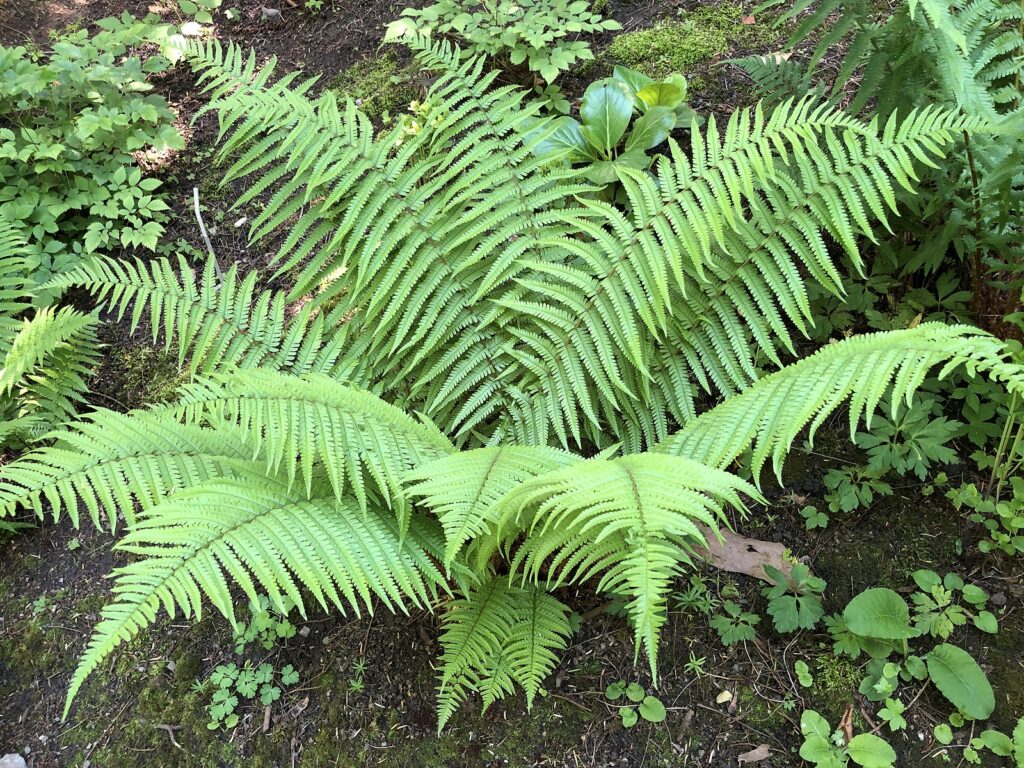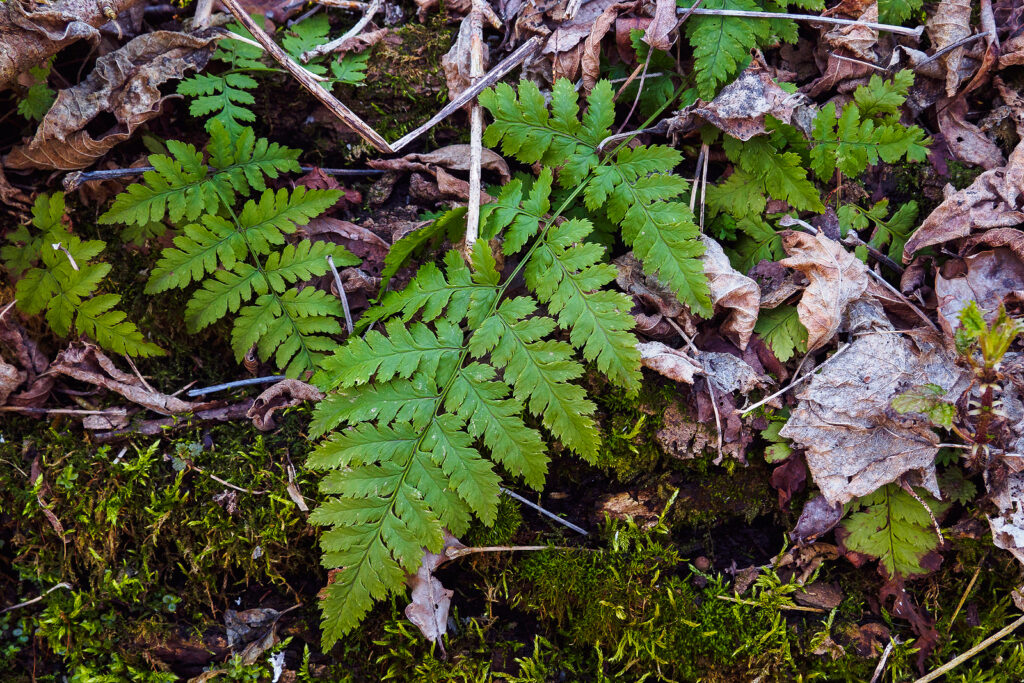Dryopteris is a genus of ferns commonly known as wood ferns. These plants are characterized by their leathery, lance-shaped fronds that arise from a central crown. They typically have a symmetrical growth habit and can range in size from small clumping ferns to large, tree-like specimens.
Dryopteris ferns that can be grown in a shaded or partially shaded location with moist, well-draining soil. Dryopteris ferns are typically found in moist woodland habitats, where they thrive in rich, well-draining soil. They are known for their tolerance to a variety of light conditions, from full shade to dappled sunlight.
Dryopteris can be grown both indoors and outdoors. These ferns are popular in gardens and landscapes for their attractive foliage and relatively low maintenance requirements. They can provide a lush, green backdrop in shaded areas and are often used in woodland garden designs. Dryopteris ferns are a versatile and resilient plant that add a touch of natural beauty to any garden setting.
Dryopteris is a genus of about 225 species, most native to moist woodland and boggy sites in the Northern Hemisphere.

Get to know Wood Fern – Dryopteris
- Plant type: Fern
- Growing zones and range: Zones 4 to 9 depending on the variety
- Hardiness: Top growth will be killed back by frost and freezing temperatures
- Height and width: 18 inches to 4 feet tall and wide depending on the variety
- Foliage: Pinnate fronds have a dense brown, gold black, or tan scales; fronds usually form vase-shaped clumps
- Uses: Shade or woodland gardens; some as houseplants
- Common name: Wood fern
- Botanical name: Dryopteris
- Family name: Dryopteridaceae
- Origin: Northern Hemisphere
Where to plant Wood Fern – Dryopteris
- Dryopteris ferns prefer indirect light or shade. They can be grown where they receive filtered sunlight. Dryopteris can not tolerate direct sunlight.
- Indoors grow Dryopteris in filtered light such as near a window with sheer curtains.
- Grow Dyopteris in well-drained soil rich in organic matter.
- Add a mix of peat moss, perlite, and sand to the planting hole or to a container for growing Dryopteris ferns.
- Dryopteris ferns prefer moderate temperatures between 55-75°F (13-24°C). They also prefer high humidity levels, so consider using a humidifier or placing a tray of water near the plant to increase humidity when growing Deyopteris indoors
When to plant Wood Fern – Dryopteris
- Plant Dryopteris in the spring or fall.

Planting and spacing Wood Fern – Dryopteris
- Plant Dryopteris 2 to 4 feet apart depending on the variety. Most can be grown about 24 inches apart.
- Dig a hole that is slightly larger than the plant’s root ball and place the plant in the hole. Cover the roots with soil and water thoroughly.
How to water and feed Wood Fern – Dryopteris
- Dryopteris grows best where the soil is consistently moist but not waterlogged. Water Dryopteris thoroughly whenever the top inch of soil feels dry to the touch. Mist the leaves occasionally to increase humidity.
- Water Dryopteris ferns regularly, especially during dry periods. Avoid overhead watering, as this can lead to fungal diseases.
- Fertilize Dryopteris with a balanced liquid fertilizer every 4 to 6 weeks during the growing season (spring and summer). Reduce or stop fertilization during the fall and winter months when the plant is in its dormant phase.
- Apply a balanced, slow-release fertilizer in the spring to promote healthy growth. Follow the instructions on the fertilizer package for the correct application method and amount. Avoid over-fertilizing, as ferns are sensitive to excess nutrients.
Wood Fern – Dryopteris care
- Mulch around the base of Dryopteris to help retain moisture in the soil and suppress weeds. Use organic compost or mulch, such as shredded bark or leaf litter.
- Remove dead or damaged fronds as needed to improve the appearance of the plant. Prune back old fronds in the spring to make room for new growth.
- During the winter, protect outdoor Dryopteris plants from harsh cold temperatures and frost by covering them with a layer of mulch or moving them to a sheltered location.
Wood Fern – Dryopteris pests and diseases
- Dryopteris can be attacked by mealybugs, scales, and spider mites. Treat any infestations promptly with insecticidal soap or neem oil. Make sure to inspect the plant regularly for any signs of disease, such as brown or yellow spots on the leaves.
- Keep an eye out for pests like slugs and snails, which can damage dryopteris plants. Treat any infestations promptly. Also, watch for signs of disease and treat as necessary.
Growing Dryopteris as a houseplant
- Use a well-draining potting mix that is rich in organic matter. A mix of peat moss, perlite, and sand can work well for growing Dryopteris ferns.
- Repot Dryopteris ferns every 1-2 years to refresh the soil and provide more space for growth. Choose a slightly larger pot and carefully transplant the fern into the new container.

Wood Fern – Dryopteris propagation
- Dryopteris ferns can be propagated by dividing the rhizomes in the spring or fall. Carefully separate the rhizomes and plant them in separate containers or areas of the garden.
Wood Fern – Dryopteris varieties to grow
- Dryopteris affinis, called golden-scaled male fern: semi-evegreen to evergreen species grows 2 to 3 feet tall and wide with golden brown scales; cultivars include “Cristata’ or ‘The King’ with fronds from 2 to 4 feet long.
- D. erythrosora, commonly called autumn fern: evergren to deciduous species grows to 2 feet tall with bronze- to copper red fronds in spring that slowly turn green by summer; grows to 18 inche tall and wide.
- D. flix-mas, commonly called male fern: grows to 3 feet tall and wide with crested fronds.
- D. intermedia, called intermediate shield fern; quick growing species to 24 inches tall.
- D. marginalis, called marginal wood fern: fronds grow to 2 feet tall, not drought-tolerant.















